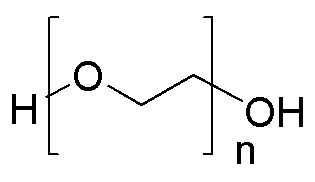Poly(ethylene glycol) is widely utilized in research focused on:
- Pharmaceutical Formulations: It serves as a solvent, plasticizer, and stabilizer in drug formulations, enhancing the solubility and bioavailability of active ingredients.
- Biotechnology: Commonly used in protein and enzyme formulations, it helps maintain stability and activity, making it essential in the production of biopharmaceuticals.
- Cosmetics and Personal Care: Its moisture-retaining properties make it a popular ingredient in lotions and creams, providing hydration and improving texture.
- Food Industry: Used as a food additive, it acts as a humectant and thickening agent, improving the texture and shelf-life of various food products.
- Industrial Applications: In manufacturing, it is employed as a lubricant and surfactant, enhancing the performance of various industrial processes.
General Information
Properties
Safety and Regulations
Applications
Poly(ethylene glycol) is widely utilized in research focused on:
- Pharmaceutical Formulations: It serves as a solvent, plasticizer, and stabilizer in drug formulations, enhancing the solubility and bioavailability of active ingredients.
- Biotechnology: Commonly used in protein and enzyme formulations, it helps maintain stability and activity, making it essential in the production of biopharmaceuticals.
- Cosmetics and Personal Care: Its moisture-retaining properties make it a popular ingredient in lotions and creams, providing hydration and improving texture.
- Food Industry: Used as a food additive, it acts as a humectant and thickening agent, improving the texture and shelf-life of various food products.
- Industrial Applications: In manufacturing, it is employed as a lubricant and surfactant, enhancing the performance of various industrial processes.
Documents
Safety Data Sheets (SDS)
The SDS provides comprehensive safety information on handling, storage, and disposal of the product.
Product Specification (PS)
The PS provides a comprehensive breakdown of the product’s properties, including chemical composition, physical state, purity, and storage requirements. It also details acceptable quality ranges and the product's intended applications.
Certificates of Analysis (COA)
Search for Certificates of Analysis (COA) by entering the products Lot Number. Lot and Batch Numbers can be found on a product’s label following the words ‘Lot’ or ‘Batch’.
*Catalog Number
*Lot Number
Certificates Of Origin (COO)
This COO confirms the country where the product was manufactured, and also details the materials and components used in it and whether it is derived from natural, synthetic, or other specific sources. This certificate may be required for customs, trade, and regulatory compliance.
*Catalog Number
*Lot Number
Safety Data Sheets (SDS)
The SDS provides comprehensive safety information on handling, storage, and disposal of the product.
DownloadProduct Specification (PS)
The PS provides a comprehensive breakdown of the product’s properties, including chemical composition, physical state, purity, and storage requirements. It also details acceptable quality ranges and the product's intended applications.
DownloadCertificates of Analysis (COA)
Search for Certificates of Analysis (COA) by entering the products Lot Number. Lot and Batch Numbers can be found on a product’s label following the words ‘Lot’ or ‘Batch’.
*Catalog Number
*Lot Number
Certificates Of Origin (COO)
This COO confirms the country where the product was manufactured, and also details the materials and components used in it and whether it is derived from natural, synthetic, or other specific sources. This certificate may be required for customs, trade, and regulatory compliance.


